Why My Kh Goes Up Again in Fish Tank
Adjacent up in our beginner'southward guide to water chemistry is KH.
With KH's ability to directly impact the pH of your tank, you'll desire to watch it darn closely.
Today, I'm going to teach you everything you need to know almost KH.
What is aquarium KH?
Carbonate hardness is referred to as KH for short. Information technology's basically a measure out of carbonates (CO3) and bicarbonates (HCO3) dissolved in your water.
Don't worry! You don't demand to retrieve those words. You lot simply need to know what KH is and why it's of import. And, that is actually elementary…
Think of KH as a protective barrier that surrounds your pH. As your aquarium creates acids, they eat away at KH instead of affecting your pH
However, this barrier is non permanent and once gone, your pH is costless to motility effectually again.
The college the KH of your aquarium, the more acrid it can neutralize earlier the pH is affected.
KH is invisible. While it exists in your h2o, you won't be able to know how much is there without a special test kit.
Yous might also hear KH referred to as the alkalinity of the h2o.
Important: Don't misfile alkalinity with alkaline metal.
- Element of group i: The reverse end of the pH scale to acidic (besides referred to as basic).
- Alkalinity: The mensurate of acid neutralization (KH).
And just to confuse you lot more than, you may also hear KH referred to every bit the following…
- Carbonate hardness
- Temporary hardness
- Total alkalinity
- Buffering capacity/buffer
- Acid-neutralizing capacity (ANC)
These can all be used interchangeably. And so, if they ever come up in conversation, remember that they all refer to the same thing:
KH!
FishLab Fact: Carbonate Hardness is shortened to KH considering it is derived from the the German spelling of the word, Karbonate Hardness.
What is the difference betwixt KH and GH?

Beginners often confuse carbonate hardness (KH) with general hardness (GH). While both have the discussion hardness in their proper name, they measure unlike parameters of your water.
Carbonate hardness (KH): The measure of carbonates and bicarbonates dissolved in water.
General hardness (GH): The measure of magnesium and calcium dissolved in water.
If you have ever heard someone say…
I have really difficult water where I live.
They are talking about GH.
In nature, GH and KH go hand in paw. If a waterway has a loftier GH, information technology volition besides accept a high KH.
Simply tap water is usually anything just natural…
It's actually possible for your tap water to take a actually high GH and a very low KH. And then, just having a high GH does not automatically mean that you also have a high KH.
Why is KH important to your aquarium?
As I touched on earlier, KH prevents acids from causing your pH to swing.
Rapid changes in pH tin can shock and even kill your fish. And then yeah, it'south something you want to avert!
Now, here is what yous might not be aware of:
Your aquarium constantly produces acids.
You know those beneficial leaner that alive in your filter, the ones you introduced when you cycled your tank? Well, they are to blame.
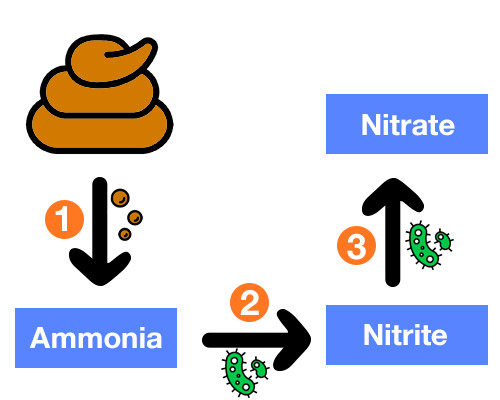
Yous encounter, fish poop breaks down into ammonia. Beneficial bacteria that live in your filter plough the ammonia into nitrite and then finally into nitrate.
But here's the affair…
Nitrite and nitrate are acidic!
And considering they are constantly existence produced, the pH of your aquarium volition decrease over fourth dimension.
If your KH is low or non-existent, and then nix can neutralize these acids.
This leads to an unsafe drop in pH that tin make the h2o toxic for fish and plants.
KH is the invisible superhero in your tank that stops this from happening. Equally you see, information technology'south important to maintain some level of KH in your tank, no matter what species y'all keep.
In saltwater tanks, KH serves a second purpose. Corals use carbonates to build their exoskeletons. If you are creating a reef tank, y'all'll need to picket that KH!
FishLab Tip: Have you always tried to lower the pH of your tank but noticed it didn't change? KH is preventing the alter. Yous need to reduce your KH before yous can adjust the pH.
What is the best KH level for your tank?
The platonic KH levels entirely depend on what you stock in your tank.
Allow's look at the suggested ranges for different types of aquariums. While the measurements can exist listed as role per 1000000 (PPM), I prefer to utilize degrees of carbonate hardness (dKH).one dKH is about equivalent to 17.9 ppm
Please notation, the following recommendations are rough guidelines only. Your specific fish, plants or invertebrates may require more than precise KH levels outside these ranges.
Freshwater KH
| Tropical Fish Tank | 4-8 dKH |
| Shrimp Tank | 2-5 dKH |
| African Cichlid Tank | 10-18 dKH |
| Discus | 3-8 dKH |
| Planted Tank | 3-8 dKH |
| Brackish Tank | 10-18 dKH |
| Swimming | 4-8 dKH |
Saltwater KH
| Saltwater Tank | 8-12 dKH |
| Reef Tank | 8-12 dKH |
Will increasing my KH likewise enhance my pH?
Yep!
The two go hand in hand.
Mostly, as KH rises and then does pH. But don't permit this scare you away from maintaining a good for you KH.
Having a stable pH that is a fiddling high is much better than a pH that swings up and down all the time.
How do you lot test the KH of your aquarium?
It's of import to know the KH level of your water.
Unfortunately, considering KH is invisible, you'll need a special aquarium examination kit to do it…
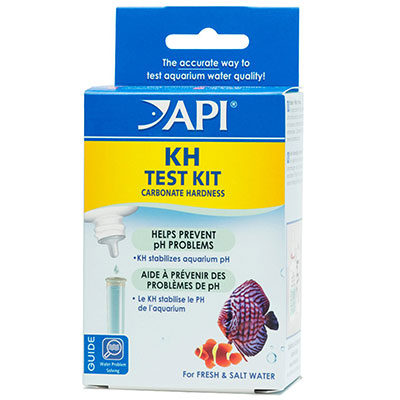
Don't worry! It'south affordable and piece of cake-to-employ. Best of all, a single KH test kit can last for hundreds of tests – just follow the instructions.
Note: The results of the examination can be given in dKH or PPM. Which y'all use is a matter of choice. I personally use dKH and refer to information technology from now on.
While there are aquarium test strips available that can also test for KH, I don't recommend them. Based on personal experience, test strips are much less accurate than liquid exam kits.
You may be wondering…
How oftentimes should y'all test the KH of your aquarium h2o?
Well, it all depends on the results of your test kit.
For freshwater tanks
- four dKH or lower: Bank check your KH weekly.
- 5 dKH or college: Bank check your KH monthly.
You should exam not merely your tank but also your tap water. This will give you a greater understanding of how to get about adjusting your KH if you need to.
For saltwater tanks
I recommend testing your KH weekly. You should also bank check the KH of your salt mix, just to make sure everything is as it should be.
How do you increase KH?
Tested your aquarium water and want to heighten your KH?
Permit'south take a closer look at how yous tin can practice exactly that.
ane. H2o changes

Many water supplies across America have a KH loftier enough that performing a water change will replenish the KH levels in your freshwater tank.
Test your tap water and run into if information technology is over 4 dKH. If so, a weekly 25% water change will replace the depleted KH.
Accept this time to likewise maintain your tank. I highly recommend buying a good gravel cleaner and using it to suck all the gunk out of your substrate. Doing then will help preclude nitrates from edifice up and decreasing your KH.
Every bit for saltwater tanks, a skillful common salt mix should contain all the essential ingredients needed to restore the KH in your tank.
2. Alkalinity buffers
Many aquarium brands industry their own line of element of group i buffer products. Depending on the brand, they may rely on baking soda, soda ash or phosphate to increase KH.
So, why wouldn't yous use each of these individual products instead?
Well, the manufacturers of alkalinity buffers have spent a great bargain of time ensuring consistency. These ingredients are mixed with other elements to ensure that you accomplish your expected KH.
For beginners, I personally recommend using an alkalinity buffer over other methods in this list considering it takes the guesswork out of adjusting your KH.
Best of all, there is an alkalinity buffer designed to match exactly what y'all stock in your aquarium…
Freshwater Tank Alkalinity Buffer
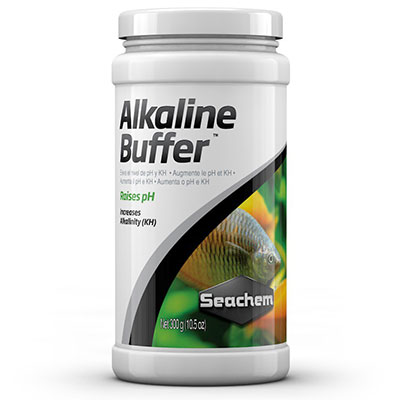
Marine Tank Alkalinity Buffer
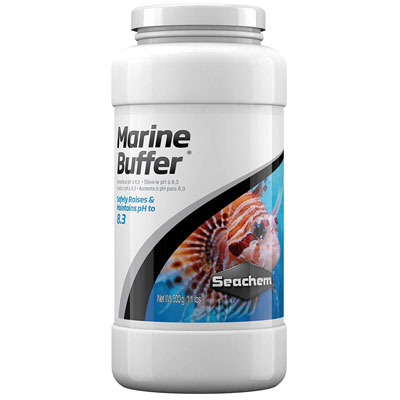
Reef Tank Alkalinity Buffer

In that location are even alkalinity buffers designed for specific species of fish, including…
- Goldfish buffer
- Discus buffer
- Malawi Victoria buffer
- Tanganyika buffer
- Arowana buffer
There really is an alkalinity buffer for everyone!
FishLab Tip: Avoid phosphate-based buffers. Phosphates tin can deplete essential minerals like calcium and magnesium from your aquarium. As well, high phosphate levels can help fuel algae outbreaks and stunt coral growth.
3. Crushed coral

Yep, this is exactly what information technology sounds similar. Crushed coral comes from dead coral reefs. Because it is high in calcium carbonate, crushed coral can aid boost your tank's KH.
Crushed coral tin can either exist mixed in with your substrate or placed in a media bag and added to your filter.
Best of all, y'all don't need to add it to your tank constantly. You simply let it sit there and exercise its affair.
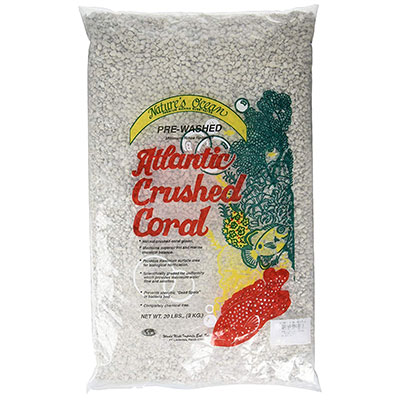
How does it work?
Recollect those acids I mentioned earlier in the guide?
Well, these acids react with the crushed coral, causing it to release calcium and carbonate into your water, raising both the KH and GH.
How much crushed coral should you utilise?
It doesn't really matter. Y'all encounter, adding more than crushed coral volition just cause it to increase the KH and GH faster.
Still, given enough fourth dimension, a small or big amount of crushed coral volition eventually enhance the KH and GH to the same point. Your water volition equalize.
This is because as your pH rises, it becomes less acidic, and the coral won't release as much calcium and carbonate.
I personally recommend adding crushed coral to your filter. If you add crushed coral to your gravel, it can compact over fourth dimension, trapping fish waste, uneaten nutrient and other gunk. If you do add it to your gravel, simply use a small amount rather than laying downward a thick layer.
4. Aragonite
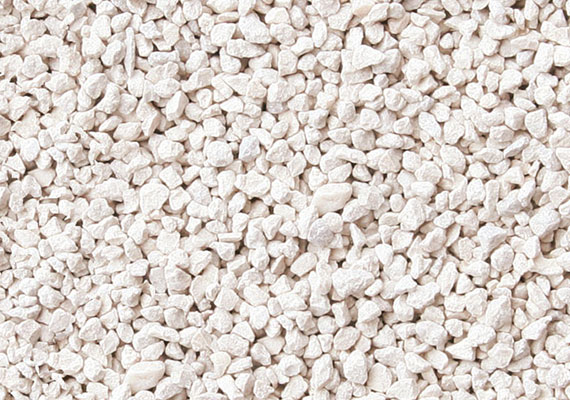
Aragonite is the crystal form of calcium carbonate (CaCO3). Just like with crushed coral, acids in the h2o cause aragonite to release calcium and carbonate.
However, unlike crushed coral, aragonite is made up of tiny sand-similar grains. Considering of this, it is frequently used as a substrate sand in both freshwater and saltwater aquariums.
Aragonite tin can greatly increase pH, GH and KH over fourth dimension. So, information technology'southward all-time suited to difficult-water-loving fish like African cichlids.
I don't recommend aragonite for beginners. If y'all decide it's messing up your water parameters, you'll have to remove the entire substrate – a frustrating task once your tank is gear up.
five. Dolomite rock
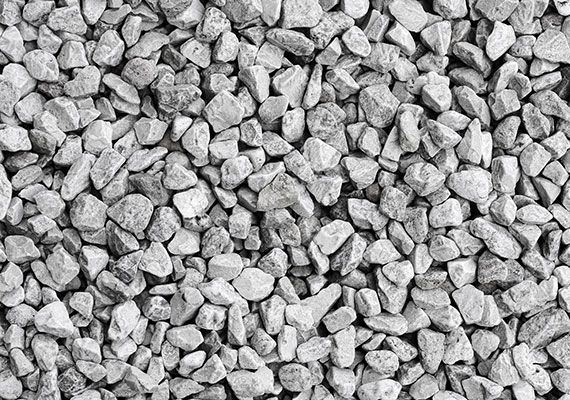
Dolomite rock, sometimes called dolostone, is a calcareous rock fabricated up mostly of calcium, magnesium and carbonate CaMg(CO3)2.
As y'all might expect, it volition release all three of these elements into your aquarium, raising both the KH and GH of your tank.
Dolomite will release less of these ingredients at a higher pH. Considering of this, dolomite is more commonly used in freshwater aquariums. The higher pH of saltwater tanks reduces the dolomite's effectiveness.
Dolomite is available in a wide diversity of colors, making it suitable to exist used every bit a substrate.
6. Soda ash
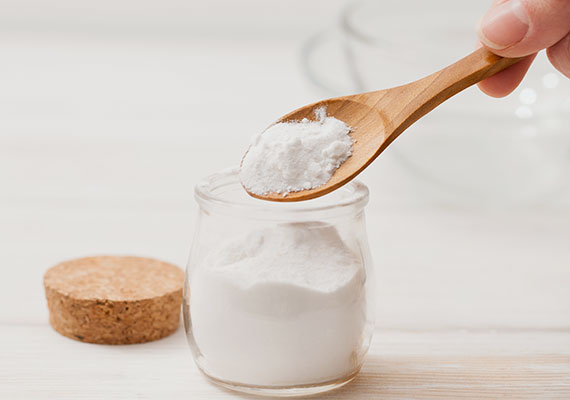
Soda ash is sodium carbonate (Na2CO3). Considering it can greatly increment pH, it is more often than not used in saltwater tanks.
If you lot desire to add soda ash to your tank, it'due south best to add together small-scale daily doses rather than a larger weekly dose. This volition requite you a better opportunity to react to how it is affecting your pH.
How much soda ash should you utilize? Majority Reef Supply has a great calculator that takes the guesswork out of dosing.
How exercise you decrease KH?
As I mentioned before, KH helps prevent your pH from dropping.
But what if the pH of your tank or tap water is too high for your fish or planted tank?
Well, to lower your pH, yous first accept to lower your KH.
And if your water has a naturally high KH, and then you have to lower that before you take any success at reducing the pH.
While raising your KH is a simple task, lowering information technology is more than difficult. A balance needs to be struck between KH and pH. Otherwise, you'll experience pH swings that can kill your fish.
Decreasing KH is really only done in freshwater aquariums. Allow's take a closer expect at the dissimilar ways to reduce the KH levels of your tank…
1. Acid buffers
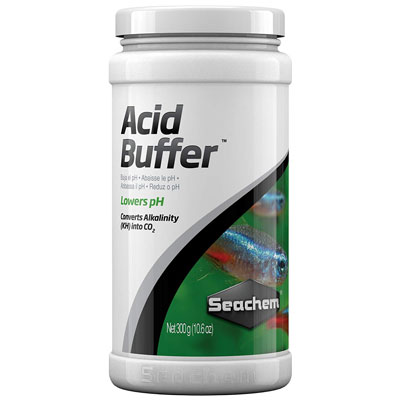
To put it but, acid buffers convert KH to carbon dioxide (CO2). The result is a reduced KH and a lower pH.
My number ane tip when using an acrid buffer:
Go slow!
Acrid buffers are primarily used in planted tanks where the plants remove the extra carbon dioxide from the h2o.
Still, if you don't have plants, overdosing tin result in both excess CO2 and a plummeting pH.
And, the cease consequence is a bunch of dead fish.
So again, follow the instructions and take your time. You can always add together more than later.
2. Distilled water
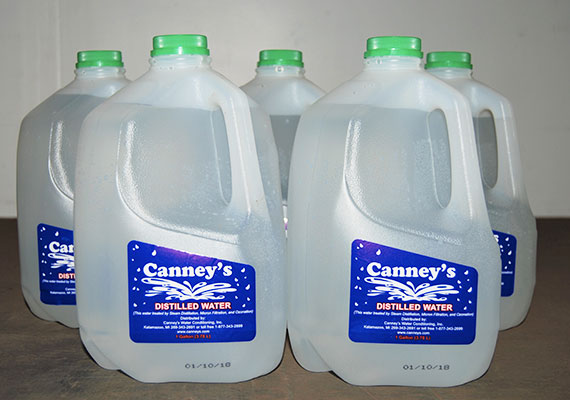
Distilled h2o is water that has undergone a special procedure to make information technology pure…
The water is heated until it turns to steam, it is then passed through a libation and nerveless in a separate container. All the impurities are left behind. The event is nearly pure water – no KH.
You lot can find it on the shelf of your local grocery shop in gallon jugs.
Now, you want to mix this water with your tap water as you still want some KH and GH.
But by mixing information technology with say 50% tap h2o, it will adjust the KH accordingly. Use your aquarium exam kit to determine the correct ratio.
The downside is the price. Fifty-fifty though distilled water is fairly cheap per gallon, the costs can soon add together up. Weekly water changes on a big tank can crave a surprising corporeality of water.
For this reason, distilled water is best used for smaller tanks.
If yous have a larger-sized aquarium, and so my side by side solution is more appropriate.
3. RO/DI water

Brand your own pure water with i of the following units:
- Reverse Osmosis (RO) System
- Deionization (DI) Filter
Both of these devices tin can be used to create "pure water" with no KH.
While the prepare-up costs may be pricey, it will salve you a considerable amount of money in the long term, especially if you buy bottles of distilled h2o each week.
Just like distilled water, you want to mix RO/DI water with your tap water to ensure there is at least some KH and GH. The RO/DI water volition reduce your KH proportionately to how much yous mix in.
If you take a saltwater tank, information technology's basically expected that you will have one of these units nearby.
4. Indian almond leaf

Indian almond leaf is a favorite for lowering the KH and pH of freshwater tanks. It's particularly popular in betta tanks.
Every bit the Indian almond leaves break down in your tank, they release tannic acid (tannins). These tannins eat abroad at the KH.
Indian almond leaves may also accept medicinal properties, naturally protecting betta from peel bug and helping wounds heal.
For more information, check out FishLab'southward detailed Indian almond leaf guide.
The downside to Indian almond leaves is that they gently lower the KH and pH of your aquarium water. If your water has a significantly high KH, yous might not notice much of a divergence.
5. Peat moss

Peat is dried and chopped peat moss. Put it in a mesh bag and place information technology inside your filter.
Like Indian almond leaves, peat leaches tannic acrid (tannins) into the h2o to reduce the KH and pH a bit. Again, it's best used where only a small reduction in KH is needed.
If yous want to use peat to lower your KH, buy an aquarium-safe diversity. Many types of peat are sold for utilize in gardening and are mixed with chemicals to cut down on mold, which could kill your fish.
Why should your KH levels NEVER attain cipher?
For freshwater aquariums, you might take come across advice to lower your KH to nix.
A KH of cipher is particularly unsafe because information technology can lead to unsafe drops in pH that makes the tank toxic to both fish and plants.
Ideally, you want to maintain at least some level of KH in your tank, no affair what blazon of species you keep.
I most normally come across this advice for fish like discus or certain types of shrimp. And yes, it'south truthful there are plenty of fish that live in a natural surroundings where the water has a KH very shut to zero.
But here'southward the thing. Those waterways accept a LOT of other variables that assist keep the pH level relatively stable.
No affair how hard you endeavour, you cannot consistently replicate that environment in something equally pocket-size as your aquarium.
Unless y'all are an expert fish keeper, I highly recommend that your aquarium has some degree of KH.
Fish need a stable pH for long and salubrious lives. KH helps y'all achieve just that.
Determination
For beginners, KH is i of the virtually overlooked and least understood elements of aquarium chemistry. And, I can't aid only feel that API not including a KH test in their master test kit is function of the reason.
But never fearfulness because now y'all know everything there is to know about it.
Equally you lot meet, KH plays a vital office in keeping your water parameters stable.
Without it, your pH would bounce all over the place, stressing your fish and causing all kinds of problems.
And if you desire to adapt your pH, then y'all need to alter your KH first.
Do you examination your tank's KH levels? Let me know in the comments below!
Source: https://fishlab.com/aquarium-kh/